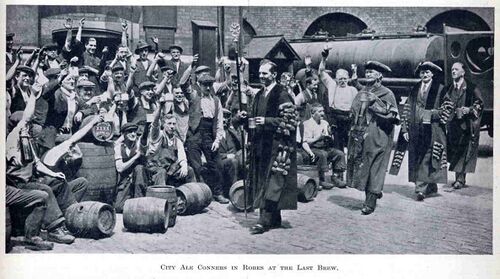Last Brew of Hoare & Co
From THE BREWING TRADE REVIEW 1st July 1934
BREWHOUSE WHICH BEGAN IN A HOSPITAL
THE site of the Red Lion Brewery has been associated with brewing from' time immemorial. The earliest of brewhouses is believed to have been that of the ancient hospital of St. Katherine. At the end of the 15th century it had become a public brewery where the citizens of London could bring their malt, and, for a fee to the Exchequer, brew their own ales.
Even then the place was one of the most important centres of brewing in London. In a 16th century map it is described as the "great breweries of Berchouse",standing "below St. Katherine's on the river side."
Another writer, Pennant, declared "while that from the Stygian gin enervates and incapacitates, tho London porter drinkers are enabled to undergo tasks that ten-gin drinkers would sink under."
Horace Walpole refers to Humphrey Parsons as "the Jacobite brewer" and "A Hymn to Alderman Parsons our Lord Mayor," dated 1741, describes him as "a Churchman, an incorruptible Tory, and as being proof against the bribery and wiles of the Whigs." It proceeds :— "In Franco he is respected The French king does agree That he should bring his beer Over there duty free."
The then owner of Sandringham Hall, Henry Hosto Henley, owned the freehold of the brewery in 1745. The Hoare family first became interested
The earliest known regulation regarding the brewery was made in 1492, when Henry VII licensed John Merchant, a Fleming, to export "50 tons of Ale, called Barre."
In the same reign "one GeiTry Gate, probably an officer of the King, spoiled the brewhouses of St. Katherine's twice, either for sending too much abroad unlicensed, or for brewing it too weak for home customers." Several of the breweries, before absorption into the Red Lion Brewhouse, were in the possession of the Abbot and Convent of Our Lady of Graces, and were forfeited to the Crown in 1539 by Henry VIII, who granted them to Sir Arthur Darcey. Among these breweries were the King's Brewhouse, from which the Court was supplied with beer, the Hartshorn, the Fleur de Lys, the Three Kings, and the Katherine Whole. The Red Lion was escheated to the &own in 1580, and was granted by Queen Elizabeth, by letters patent, to her favourite, Robert, Earl of Leicester, and John Morley. Every drop of vinegar consumed in England in the later years of Queen Elizabeth's reign must have come from the Red Lion. According to its records, one Richard Drake, who may have been a relative of the great Sir Francis, and who held office as an "Equerry of the Table," received a 21 years' monopoly from the Crown. He assigned the licence to William C,atcher, brewer of the Red Lion Brewhouse, who thus had the sole right of brewing ale and beer " to be converted and used to and for the making of aquacompositae, aquavitae, beer, vinigar, beeregar or allegar." About the time of the Restoration the brewery passed into the hands of John Parsons, Lord Mayor of London in 1703, and the representative of Reigate in every Parliament (except the Convention Parliament and that of 1698) from 1685 to 1717, the year of his 'death. His son, Humphrey, had the unusual distinction of serving twice as Lord Mayor of London (in 1730 `. and 1740), and was accorded the monopoly of supplying English beer to the French C,ourt. He was granted the privilege in return for his courteous gesture in presenting his horse to Louis XV at the end of a day's hunt. Parson's beer had a great reputation. Goldsmith, in his description of authors' bedchambers, praises Parson's "black champagne."
in the brewery in 1802, when Henry Hoare, a partner in the bank, bought a share for a younger son. The business passed from father to son until 1894, when a limited company was formed.
The brewery was recently amalgamated with Messrs. Charrington & Co. Ltd., at whose Anchor Brewery in Mile End Road, E., the beers formerly brewed at the Red Lion will now be produced.
